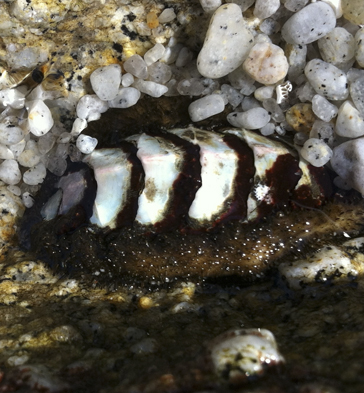Published in the Ocean Watch column, Honolulu Star-Advertiser © Susan Scott
January 13, 2014
While I was sitting on an airplane in freezing-cold Milwaukee last week, a burst of warmth came to me in an email from Andy, a Hawaii friend visiting California. With the subject “What is dat?” Andy sent a photo and a note: “Creature is about 5 cm (2 inches) long adhering tightly to the tidal zone in Pacific Grove (Monterey Bay). I realize you’re more of a tropical ocean watcher, but maybe you know. Looks like son of trilobite.”
 Chiton.
Chiton.
Courtesy Andy Swartz
While I was sitting on an airplane in freezing-cold Milwaukee last week, a burst of warmth came to me in an email from Andy, a Hawaii friend visiting California. With the subject “What is dat?” Andy sent a photo and a note: “Creature is about 5 cm (2 inches) long adhering tightly to the tidal zone in Pacific Grove (Monterey Bay). I realize you’re more of a tropical ocean watcher, but maybe you know. Looks like son of trilobite.”
It’s true that I prefer my ocean watching in warm water and tropical air, but then, so do some close cousins of the creature in the picture. Andy’s animal was a chiton, pronounced KITE-on.
Chitons remind people of trilobites, hard-shelled creatures that went extinct before dinosaurs existed, but the two aren’t related. Trilobites had jointed legs; chitons have no legs. They do, however, have a foot, a common feature in their animal grouping, the mollusks. Snails, clams, squid and octopuses are all mollusks, as are the 800 or so species of chitons that inhabit the world’s oceans.
Each chiton has eight overlapping plates across its back with a band of leathery flesh surrounding them called a girdle. Underneath is the chiton’s suction-cup foot which clings to rocks with the same doggedness as an opihi (limpet).
Most chitons live near the surge zone, where they graze on algae. During the day the animals rest under rocks, but come dusk they venture out in search of food.
A few species live to 5,000 feet deep, a dark place where plants can’t grow. These meat-eating chitons seek out tiny crustaceans, smothering them under the thick girdles.
Chiton mouths are just ahead of the muscular foot, but since the creatures have no tentacles, it’s hard to tell heads from tails on a chiton. Most grow to only a few inches long, but one called the gumboot chiton lives along the North Pacific coasts of America and Asia and grows to 13 inches long.
Hawaii hosts four chiton species a half-inch to 11⁄2 inches long. Ancient Hawaiians called them either pupu moo, meaning “lizard shell,” or pupu peelua, “caterpillar shell.”
Hawaiians didn’t eat chitons, but used them in ceremonies for firstborn babies. Aboriginal Australians roasted and ate these girdle-wearing mollusks, and aboriginal Bermudans used them in soup.
For good photos and stories about chitons and other trilobite pretenders, visit Hawaii biologist Sam Gon’s website: www.trilobites.info/triloimposters.htm.
I’ve not seen chitons in Hawaii, but now that I know they’re here, I’ll be looking — as long as it’s sunny with water and air about 80 degrees. (We can help Hawaii’s native marine animals by returning disturbed rocks to the positions in which we found them.)